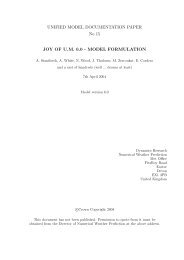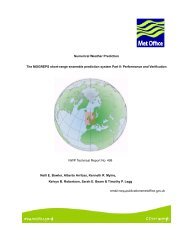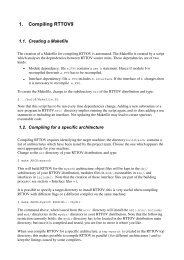Formulation of a balanced Exner pressure in the Lateral ... - Met Office
Formulation of a balanced Exner pressure in the Lateral ... - Met Office
Formulation of a balanced Exner pressure in the Lateral ... - Met Office
You also want an ePaper? Increase the reach of your titles
YUMPU automatically turns print PDFs into web optimized ePapers that Google loves.
3.2 Implementation <strong>in</strong> <strong>the</strong> Unified ModelThis solution was implemented <strong>in</strong> <strong>the</strong> UM as a new subrout<strong>in</strong>e BALANCE LBC VALUES, which adjusts<strong>the</strong> <strong>Exner</strong> pr<strong>of</strong>iles <strong>in</strong> <strong>the</strong> LBCs at <strong>the</strong> beg<strong>in</strong>n<strong>in</strong>g <strong>of</strong> each timestep. LBC data are output from <strong>the</strong> driv<strong>in</strong>gmodel as normal. These data are read <strong>in</strong> by <strong>the</strong> limited area model. At <strong>the</strong> beg<strong>in</strong>n<strong>in</strong>g <strong>of</strong> each timestep,balance is applied to prevent spurious vertical accelerations. Details <strong>of</strong> <strong>the</strong> exact method <strong>of</strong> adjust<strong>in</strong>g<strong>the</strong> <strong>Exner</strong> pr<strong>of</strong>iles is provided below. F<strong>in</strong>ally, <strong>the</strong> model values along <strong>the</strong> boundaries are blended with<strong>the</strong> LBC values.The UM grid is staggered on an Arakawa C-grid <strong>in</strong> <strong>the</strong> horizontal and a Charney-Phillips grid <strong>in</strong> <strong>the</strong>vertical. Equation 2 is discretised as follows,( )c pd θvk Π k+1 − Π k u 2 rot + v2 rot=− frρk+1 − rρk rθk 1 v rot + f 2 u rot − g (3)where horizontal and vertical <strong>in</strong>terpolation <strong>of</strong> <strong>the</strong> w<strong>in</strong>ds onto θ po<strong>in</strong>ts is carried out as follows,( 1u i,j = w 12 u i−1,j,k + 1 ) ( 12 u i,j,k + w 22 u i−1,j,k+1 + 1 )2 u i,j,k+1 .Indices, i, j, k, <strong>in</strong>dicate <strong>the</strong> horizontal and vertical location <strong>of</strong> a grid po<strong>in</strong>t, and w 1 and w 2 are<strong>in</strong>terpolation coefficients. At <strong>the</strong> top model level, an upper boundary condition is applied, u N =u Nand v N =v N . Equation 3 can be re-arranged to allow a <strong>balanced</strong> <strong>Exner</strong> pr<strong>of</strong>ile to be constructed by<strong>in</strong>tegrat<strong>in</strong>g from <strong>the</strong> lowest model level upwards, given <strong>the</strong> pr<strong>of</strong>iles <strong>of</strong> potential temperature and w<strong>in</strong>d,Π k+1 = Π k + rk+1 ρ − rρkc pd θvk⎛⎝( )u 2 rot + v2 rotr k θ⎞− f 1 v rot + f 2 u rot − g⎠ .Issues arise when <strong>in</strong>terpolat<strong>in</strong>g <strong>the</strong> u and v w<strong>in</strong>ds horizontally due to <strong>the</strong> way LBC data are stored<strong>in</strong> <strong>the</strong> UM. LBC data are stored <strong>in</strong> memory sequentially <strong>in</strong> four segments; north, south, east and west.For po<strong>in</strong>ts near <strong>the</strong> edge <strong>of</strong> each segment, it is sometimes necessary to retrieve data from a differentLBC segment (e.g. see Figure 9) and so care had to be taken <strong>in</strong> to ensure that <strong>the</strong> data was addressedcorrectly.It is recognised that to impose a truly <strong>balanced</strong> state, <strong>the</strong> atmospheric state should be calculatedsuch that it rema<strong>in</strong>s <strong>balanced</strong> after pass<strong>in</strong>g through <strong>the</strong> semi-implicit, semi-Lagrangian dynamics <strong>of</strong><strong>the</strong> UM. The methodology adopted here would only be exact when used with an explicit time-stepp<strong>in</strong>gscheme, i.e. if <strong>the</strong> model dynamics used <strong>the</strong> same time-stepp<strong>in</strong>g scheme as <strong>the</strong> method used here.While this method will mean that <strong>the</strong> balance imposed is not exact, <strong>the</strong> results <strong>in</strong>dicate that <strong>the</strong><strong>in</strong>accuracy <strong>of</strong> <strong>the</strong> method is smaller than <strong>the</strong> imbalance which is caus<strong>in</strong>g <strong>the</strong> problem and so providesa significant improvement. The implementation <strong>of</strong> a scheme to impose an exact balance match<strong>in</strong>g<strong>the</strong> UM dynamics would prove substantially more computationally expensive than <strong>the</strong> relatively cheapscheme adopted here.After <strong>the</strong> <strong>Exner</strong> <strong>pressure</strong> pr<strong>of</strong>iles have been changed, <strong>the</strong> density must also be <strong>balanced</strong> such that<strong>the</strong> equation <strong>of</strong> state is obeyed. i.e.ρ =p 0κ d c pd θ v Π κ d −1κ dwhere κ d = R dc pd.While <strong>the</strong> New Dynamics employs a l<strong>in</strong>earised form <strong>of</strong> <strong>the</strong> equation <strong>of</strong> state, <strong>the</strong> differences result<strong>in</strong>gfrom this different def<strong>in</strong>ition were found to be negligible.10












